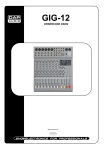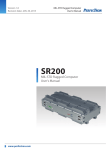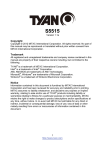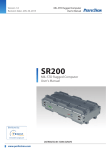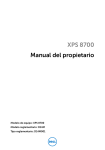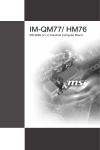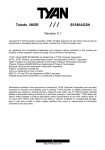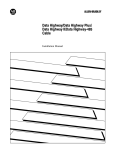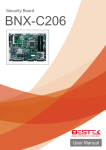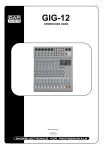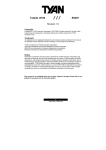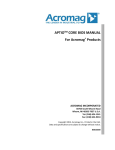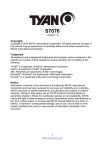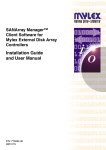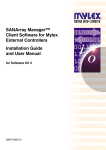Download S5533 - Tyan
Transcript
S5533 Version 1.0 Copyright Copyright © 2013 MiTAC International Corporation. All rights reserved. No part of this manual may be reproduced or translated without prior written consent from MiTAC International Corporation. Trademark All registered and unregistered trademarks and company names contained in this manual are property of their respective owners including, but not limited to the following. TYAN® is a trademark of MiTAC International Corporation. Intel® is a trademark of Intel® Corporation. AMI, AMI BIOS are trademarks of AMI Technologies. Microsoft®, Windows® are trademarks of Microsoft Corporation. ® Winbond is a trademark of Winbond Electronics Corporation. Notice Information contained in this document is furnished by MiTAC International Corporation and has been reviewed for accuracy and reliability prior to printing. MiTAC assumes no liability whatsoever, and disclaims any express or implied warranty, relating to sale and/or use of TYAN® products including liability or warranties relating to fitness for a particular purpose or merchantability. MiTAC retains the right to make changes to product descriptions and/or specifications at any time, without notice. In no event will MiTAC be held liable for any direct or indirect, incidental or consequential damage, loss of use, loss of data or other malady resulting from errors or inaccuracies of information contained in this document. 1 http://www.tyan.com About this guide This user guide contains the information you need when installing and configuring the motherboard. How this guide is organized This guide contains the following parts: Chapter1: Instruction This chapter describes the features of the motherboard and the new technology it supports. Chapter2: Board Installation This chapter lists the hardware setup procedures that you need to abide by when installing system components. It includes description of the jumpers and connectors on the motherboard. Chapter3: BIOS Setup This chapter tells how to change system settings through the BIOS setup menu. Detailed descriptions of the BIOS parameters are also provided. Chapter4: Diagnostics This chapter introduces some BIOS codes and technical terms to provide better service for the customers. Appendix I: Fan and Temp Sensors This section aims to help readers identify the locations of some specific Fan and Temp Sensors on the motherboard. A table of BIOS Temp sensor name explanation is also included for readers’ reference. 2 http://www.tyan.com Contents Before you begin… .................................................................................... 4 Chapter 1: Instruction ................................................................................ 5 1.1 Congratulations ................................................................................. 5 1.2 Hardware Specification...................................................................... 5 1.3 Software Specifications ..................................................................... 7 Chapter 2: Board Installation..................................................................... 9 2.1 Board Image .................................................................................... 10 2.2 Block Diagram ................................................................................. 11 2.3 Mainboard Mechanical Drawing ...................................................... 12 2.4 Board Parts, Jumpers and Connectors ........................................... 13 2.5 Installing the Processor and Heatsink ............................................. 21 2.6 Thermal Interface Material .............................................................. 25 2.7 Tips on Installing Motherboard in Chassis ...................................... 26 2.8 Installing the Memory ...................................................................... 28 2.9 Attaching Drive Cables .................................................................... 31 2.10 Installing Add-In Cards .................................................................. 31 2.11 Connecting External Devices ........................................................ 32 2.12 Installing the Power Supply ........................................................... 33 2.13 Finishing Up................................................................................... 34 Chapter 3: BIOS Setup ............................................................................. 35 3.1 About the BIOS................................................................................ 35 3.2 Main Menu ....................................................................................... 37 3.3 Advanced Menu............................................................................... 38 3.4 Chipset Menu .................................................................................. 62 3.5 Boot ................................................................................................. 70 3.6 Security ............................................................................................ 74 3.7 Server Management ........................................................................ 75 3.8 Save & Exit ...................................................................................... 77 Chapter 4: Diagnostics ............................................................................. 79 4.1 Flash Utility ...................................................................................... 79 4.2 AMIBIOS Post Code (Aptio) ............................................................ 80 Appendix I: Fan and Temp Sensors ....................................................... 87 Glossary..................................................................................................... 89 Technical Support .................................................................................... 95 3 http://www.tyan.com Before you begin… Check the box contents! The retail motherboard package should contain the following: 1 x S5533 Motherboard 6 x SATA Single Cable 1 x IO shield 1 x S5533 Quick Installation Guide 1 x TYAN® Driver CD IMPORTANT NOTE: Sales samples may not come with any of the accessories listed above. If you have ordered a sales sample and you are missing any of the above items, please contact your sales representative to help order accessories. 4 http://www.tyan.com Chapter 1: Instruction 1.1 Congratulations You have purchased the powerful TYAN® S5533 motherboard, based on the ® ® Intel C222 chipset. The S5533 is designed to support single Intel Xeon E31200 v3, i3 (22nm/Haswell) series processor, and up to 32GB Unbuffered ECC ® DDR3 1600/1333/1066 memory. Leveraging advanced technology from Intel , the S5533 is capable of offering scalable 32 and 64-bit computing, highbandwidth memory design, and lightning-fast PCI-E bus implementation. The S5533 not only empowers you in today’s demanding IT environment but also offers a smooth path for future application upgradeability. All of these rich feature sets provide the S5533 with the power and flexibility to meet demanding requirements for today’s IT environments. Remember to visit the TYAN® website at http://www.tyan.com. There you can find all the information on all TYAN® products as well as all the supporting documentation, FAQs, Drivers and BIOS upgrades. 1.2 Hardware Specification TYAN S5533 (S5533GM2NR-LE) Processor Chipset Memory Expansion Slots LAN Storage Graphic Supported CPU Series Socket Type / Q'ty Thermal Design Power (TDP) wattage PCH Supported DIMM Qty DIMM Type / Speed Capacity Memory voltage Intel Xeon E3-1200 v3, i3 (22nm/Haswell) series processors LGA 1150/ (1) PCI-E (1) PCI-E Gen3 x16 slots Port Q'ty Controller PHY Connector Controller SATA Speed RAID Connector type (2) GbE ports + (1) dedicated for IPMI Intel I210 Realtek RTL 8211E (6) SATA Intel C222 (2) 6.0 Gb/s (blue color), (4) 3.0 Gb/s (black color) RAID 0/1/10/5 (Intel RST) D-Sub 15-pin Max up to 95W Intel C222 (2) DIMM slots Unbuffered ECC DDR3 1600/1333/1066 Up to 32GB 1.5V 5 http://www.tyan.com Chipset Physical Dimension Form Factor Board Dimension Aspeed AST2300 (2) USB3.0 ports (at rear) / (2) USB 2.0 ports (via cable) (1) header (1) D-Sub 15-pin VGA port (2) GbE + (1) Dedicated for IPMI (1) 2x12-pin SSI front panel header (4) SATA-II and (2) SATA-III connectors Aspeed AST2300 Monitors voltage for CPU, memory, chipset & power supply Total (3) 4-pin headers Monitors temperature for CPU & memory Fan fail LED indicator / Over temperature warning indicator Onboard Aspeed AST2300 IPMI 2.0 compliant baseboard management controller (BMC) / Supports storage over IP and remote platform-flash / USB 2.0 virtual hub 24-bit high quality video compression / 10/100 Mb/s MAC interface AMI / 16MB User-configurable H/W monitoring / Autoconfigurable of hard disk types / SMBIOS 2.7/PnP/Wake on LAN / PXE boot support / ACPI 3.0/ACPI sleeping states S1,S3,S4,S5 mini-ITX 6.69" x 6.69" (170 x 170mm) Operating System OS supported list Please refer to our Intel OS supported list. FCC (DoC) CE (DoC) Operating Temp. Non-operating Temp. In/Non-operating Humidity RoHS 6/6 Compliant Motherboard Manual Installation CD I/O Shield Cable SATA Class A Yes 10° C ~ 35° C (50° F~ 95° F) - 40° C ~ 70° C (-40° F ~ 158° F) USB Input /Output COM VGA RJ-45 Front Panel SATA Chipset Voltage System Monitoring Fan Temperature LED Onboard Chipset Server Management AST2300 IPMI Feature AST2300 iKVM Feature Brand / ROM size BIOS Regulation Operating Environment RoHS Package Contains Feature 90%, non-condensing at 35° C Yes (1) S5533 Motherboard (1) Quick Installation Guide (1) TYAN installation CD (1) I/O Shield (6) SATA signal cables 6 http://www.tyan.com 1.3 Software Specifications For the latest OS (operation system) support and IPMI Configuration Guide, please visit our Web site for information. 7 http://www.tyan.com NOTE 8 http://www.tyan.com Chapter 2: Board Installation You are now ready to install your motherboard. How to install our products right… the first time The first thing you should do is read this user’s manual. It contains important information that will make configuration and setup much easier. Here are some precautions you should take when installing your motherboard: (1) Ground yourself properly before removing your motherboard from the antistatic bag. Unplug the power from your computer power supply and then touch a safely grounded object to release static charge (i.e. power supply case). For the safest conditions, MiTAC recommends wearing a static safety wrist strap. (2) Hold the motherboard by its edges and do not touch the bottom of the board, or flex the board in any way. (3) Avoid touching the motherboard components, IC chips, connectors, memory modules, and leads. (4) Place the motherboard on a grounded antistatic surface or on the antistatic bag that the board was shipped in. (5) Inspect the board for damage. The following pages include details on how to install your motherboard into your chassis, as well as installing the processor, memory, disk drives and cables. Caution! 1. 2. To avoid damaging the motherboard and associated components, do not use torque force greater than 7kgf/cm (6.09 lb/in) on each mounting screw for motherboard installation. Do not apply power to the board if it has been damaged. 9 http://www.tyan.com 2.1 Board Image S5533 This picture is representative of the latest board revision available at the time of publishing. The board you receive may not look exactly like the above picture. 10 http://www.tyan.com 2.2 Block Diagram S5533 Block Diagram 11 http://www.tyan.com 2.3 Mainboard Mechanical Drawing 12 http://www.tyan.com 2.4 Board Parts, Jumpers and Connectors This diagram is representative of the latest board revision available at the time of publishing. The board you receive may not look exactly like the above diagram. The DIMM slot numbers shown above can be used as a reference when reviewing the DIMM population guidelines shown later in the manual. For the latest board revision, please visit our web site at http://www.tyan.com. 13 http://www.tyan.com Connectors, Jumpers & Slots Connector/Jumper 1 LAN Port #1 (LAN1) + USB 3.0 Ports 2 Top: LAN Port #2 (LAN2) Bottom: BMC Dedicated LAN Port #3 (LAN3) 3 SATA2.0 Connector (SATA2, J39) 4 VGA Port 5 COM Header (J77) 12 ME Header (J50) 13 Chassis Intrusion Header (J81) 14 4-Pin Fan Connectors (SYS_FAN2, J54) 15 4-Pin Fan Connectors (SYS_FAN1, J48) 16 USB Front Panel Header (J43) 6 SATA3.0 Connector (SATA1, J44) 17 Front Panel Header (J15) 7 SATA3.0 Connector (SATA0, J38) 9 SATA2.0 Connector (SATA5, J46) 18 CPU FAN Connector (J55) 19 ATX 4-pin Power Connector (PWRCONN1) 20 ATX 24-pin Power Connector (J18) 10 SGPIO Header (J83) 21 Fault LED Header (J82) 8 SATA2.0 Connector (SATA4, J40) 11 SATA2.0 Connector (SATA3, J45) Jumpers Slots a BIOS Recovery Mode Jumper (J52) A DDR Memory Slot (DIMM_A0) b Clear CMOS Jumper (J42) B DDR Memory Slot (DIMM_B0) C PCIE Gen3 x16 Slot Jumper Legend OPEN - Jumper OFF Without jumper cover CLOSED - Jumper ON With jumper cover 14 http://www.tyan.com J55 J82 J77 J43 J48 J54 J50 15 http://www.tyan.com J48/J54/J55: 4-Pin FAN Connector Pin Signal 1 2 3 4 GND VCC TACHOMETER PWM Use this header to connect the cooling fan to your motherboard to keep the system stable and reliable. J48: SYS_FAN_1 J54: SYS_FAN_2 J55: CPU_FAN J77: COM Port Header Signal Pin Pin Signal DCD 1 2 DSR RXD 3 4 RTS TXD 5 6 CTS DTR 7 8 NRI GND 9 10 NONE J82: Fault LED Header Pin Signal 1 2 power system_fault J50: ME Header Pin Signal 3 1 2 NA Recovery GND J43: USB Front Panel Header (blue) Signal Pin 1 Pin 2 USB_DN 3 4 USB_DN USB_DP 5 6 USB_DP GND 7 8 GND GUIDE pin 9 10 NA power 16 http://www.tyan.com Signal power J83 J81 J38 J44 J15 17 http://www.tyan.com J38/J44: SATA3.0 Connector 1 2 3 4 5 6 7 7 1 GND SATA TX DP SATA TX DN GND SATA RX DN SATA RX DP GND Connects to the Serial ATA ready drives via the Serial ATA cable. J38: SATA0 J44: SATA1 J15: Front Panel Header Signal VCC SATA LED GND FP RST VCC Pin 1 3 5 7 9 Pin 2 4 6 8 10 Signal GRN BLNK HRD YLW BKNK HRD PWRBTN GND NA J83: SGPIO Header for BB HD Board Signal Pin Pin Signal SATA_LOAD 1 2 SATA_CLOCK GND 3 4 SATA_DATAOUT0 NA 5 6 SATA_DATAOUT1 J81: Chassis Intrusion Header Pin Open Short (Default) Signal 1 2 GND INTRUDER# Open: Use this header to trigger the system chassis intrusion alarm. Short: Use this header to disable the system chassis intrusion alarm. 18 http://www.tyan.com J46 J45 J52 J40 J39 J42 19 http://www.tyan.com J39/J40/J45/J46: SATA2.0 Connector 7 1 1 2 3 4 5 6 7 GND SATA TX DP SATA TX DN GND SATA RX DN SATA RX DP GND Connects to the Serial ATA ready drives via the Serial ATA cable. J39: SATA2 J45: SATA3 J40: SATA4 J46: SATA5 J52: BIOS Recovery Mode Jumper Pin 1-2 Closed: Normal (Default) Pin 2-3 Closed: BIOS Recovery J42: Clear CMOS Jumper You can reset the CMOS settings by using this jumper. This can be useful if you have forgotten your system/setup password, or need to clear the system BIOS setting. Normal (Default) Clear CMOS 1. Power off system and disconnect power connectors from the motherboard. 2. Remove the jumper from Pin_1 and Pin_2 (Default setting). 3. Move the jumper cap to close Pin_2 and Pin_3 for several seconds to Clear CMOS. 4. Put jumper cap back to Pin_1 and Pin_2 (Default setting). 5. Reconnect power connectors to the motherboard and power on system. 20 http://www.tyan.com 2.5 Installing the Processor and Heatsink The types of processors supported by the S5533 are listed in the section 1.2 Hardware Specification on page 5. Check our website at http://www.tyan.com for the latest list of validated Intel® processors for this specific motherboard. NOTE: MiTAC is not liable for damage as a result of operating an unsupported configuration. Processor Installation (Socket H3 for Intel CPU) Follow the steps described later to install the processors and heat sinks. NOTE: Please save and replace the CPU protection cap when returning for service. 1. Open the socket lever. 2. Open the CPU socket cover. 21 http://www.tyan.com 3. Remove the CPU protection cap. 4. Install the processor and make sure the gold arrow is located in the right direction. 5. Close the CPU socket cover. 6. Close the socket lever. 22 http://www.tyan.com Heat sink Installation After installing the processor, you will need to proceed to install the heat sink. The CPU heat sink will ensure that the processor do not overheat and continue to operate at maximum performance for as long as you own them. An overheated processor is dangerous to the motherboard. The processors will overheat within seconds, enter thermal protection, and shut down if heatsinks are not installed. For the safest method of installation and information on choosing the appropriate heat sink, using heat sinks validated by Intel®. Please refer to the Intel® website: http://www.intel.com ® The following diagram illustrates how to install the heatsink on the Intel H3 Socket: 1. Apply the thermal grease. 2. Install the CPU heatsink. 23 http://www.tyan.com 3. Secure the heatsink screws. 4. Connect the heatsink fan cable. 24 http://www.tyan.com 2.6 Thermal Interface Material There are two types of thermal interface materials designed for use with the processors. The most common material comes as a small pad attached to the heat sink at the time of purchase. There should be a protective cover over the material. Take care not to touch this material. Simply remove the protective cover and place the heat sink on the processor. The second type of interface material is usually packaged separately. It is commonly referred to as ‘thermal compound’. Simply apply a thin layer on to the CPU lid (applying too much will actually reduce the cooling). NOTE: Always check with the manufacturer of the heat sink & processor to ensure that the thermal interface material is compatible with the processor and meets the manufacturer’s warranty requirements. 25 http://www.tyan.com 2.7 Tips on Installing Motherboard in Chassis Before installing your motherboard, make sure your chassis has the necessary motherboard support studs installed. These studs are usually metal and are gold in color. Usually, the chassis manufacturer will pre-install the support studs. If you are unsure of stud placement, simply lay the motherboard inside the chassis and align the screw holes of the motherboard to the studs inside the case. If there are any studs missing, you will know right away since the motherboard will not be able to be securely installed. Note: Be especially careful to look for extra stand-offs. If there are any stand-offs present that are not aligned with a mounting hole on the motherboard, it will likely short components on the back of the motherboard when installed. This will cause malfunction and/or damage to your motherboard. 26 http://www.tyan.com Some chassis include plastic studs instead of metal. Although the plastic studs are usable, MiTAC recommends using metal studs with screws that will fasten the motherboard more securely in place. Below is a chart detailing what the most common motherboard studs look like and how they should be installed. 27 http://www.tyan.com 2.8 Installing the Memory Before installing memory, ensure that the memory you have is compatible with the motherboard and processor. Check the TYAN Web site at http://www.tyan.com for details of the type of memory recommended for your motherboard. ® The Intel Xeon E3-1200 v3, i3 (22nm/Haswell) series processor supports 4 DIMM slots. This platform supports Unbuffered ECC DDR3, up to 32GB. DDR3 data transfer rates of 1066, 1333, and 1600 MT/s are supported. Both 1.5V and 1.35V DDR3 DIMMs are supported All installed memory will automatically be detected. No jumpers or settings need to be changed for memory detection. All memory must be of the same type and density. Registered, Unbuffered, and LRDIMM memory types can NOT be mixed and matched on the same motherboard. 28 http://www.tyan.com Recommended Memory Population Table Single CPU Installed Quantity of memory installed 1 DIMM_A0 √ 2 √ √ DIMM_B0 NOTE: 1. √ indicates a populated DIMM slot. 2. Use paired memory installation for max performance. 3. Populate the same DIMM type in each channel, specifically - Use the same DIMM size - Use the same # of ranks per DIMM 4. Dual-rank DIMMs are recommended over single-rank DIMMs. 5. Un-buffered DIMM can offer slightly better performance than registerd DIMM if populating only a single DIMM per channel. 6. Always install with CPU0 Socket and DIMM_A0 Slot first, following the alphabetical order. 29 http://www.tyan.com Memory Installation Procedure Follow these instructions to install memory modules into the S5533. 1. Press the locking levers in the direction shown in the following illustration. 2. Align the memory module with the socket. The memory module is keyed to fit only one way in the socket. 3. Seat the module firmly into the socket by gently pressing down until it sits flush with the socket. The locking levers pop up into place. 30 http://www.tyan.com 2.9 Attaching Drive Cables Attaching SATA Cables The following illustrates how to make a SATA Cable connection. If you are in need of SATA/SAS cables or power adapters please contact your local sales representative. 2.10 Installing Add-In Cards Before installing add-in cards, it’s helpful to know if they are fully compatible with your motherboard. For this reason, we’ve provided the diagrams below, showing the slots that may appear on your motherboard. PCI-E Gen3 x16 slot Simply find the appropriate slot for your add-in card and insert the card firmly. Do not force any add-in cards into any slots if they do not seat in place. It is better to try another slot or return the faulty card rather than damaging both the motherboard and the add-in card. TIP: It’s a good practice to install add-in cards in a staggered manner rather than making them directly adjacent to each other. Doing so allows air to circulate within the chassis more easily, thus improving cooling for all installed devices. NOTE: You must always unplug the power connector from the motherboard before performing system hardware changes to avoid damaging the board or expansion device. 31 http://www.tyan.com 2.11 Connecting External Devices Connecting external devices to the motherboard is an easy task. The motherboard supports a number of different interfaces through connecting peripherals. See the following diagrams for the details. LAN1 LAN3 VGA USB3.0 LAN2 (BMC dedicated LAN) Onboard LAN LED Color Definition The three (3) onboard Ethernet ports have green and yellow LEDs to indicate LAN status. The chart below illustrates the different LED states. 1Gbps LAN Link/Activity LED Scheme Description Left LED(LED2) Link/Activity Right LED(LED1) Speed No Link OFF OFF Link Green OFF Active Blinking Green OFF Link Green Solid Green Active Blinking Green Solid Green Link Green Solid Yellow Active Blinking Green Solid Yellow Linked at 10 Mbps Linked at 100 Mbps Linked at 1 Gbps 32 http://www.tyan.com 2.12 Installing the Power Supply There are two (2) power connectors on your S5533 motherboard. The S5533 supports EPS 12V power supply. J18: ATX 24-Pin Power Connector Signal Pin Pin Signal +3.3V 1 13 +3.3V +3.3V 2 14 -12V GND 3 15 GND +5V 4 16 PS ON# GND 5 17 GND +5V 6 18 GND GND 7 19 GND Power OK 8 20 Reserve +5VSB 9 21 +5 +12V 10 22 +5 +12V 11 23 +5 +3.3V 12 24 GND PWRCONN1: ATX 4-Pin Power Connector Signal Pin Pin Signal GND 1 5 +12V GND 2 6 +12V NOTE: You must unplug the power supply before plugging the power cables to motherboard connectors. 33 http://www.tyan.com 2.13 Finishing Up Congratulations on making it this far! You have finished setting up the hardware aspect of your computer. Before closing up your chassis, make sure that all cables and wires are connected properly, especially SATA cables and most importantly, jumpers. You may have difficulty powering on your system if the motherboard jumpers are not set correctly. In the rare circumstance that you have experienced difficulty, you can find help by asking your vendor for assistance. If they are not available for assistance, please find setup information and documentation online at our website or by calling your vendor’s support line. 34 http://www.tyan.com Chapter 3: BIOS Setup 3.1 About the BIOS The BIOS is the basic input/output system, the firmware on the motherboard that enables your hardware to interface with your software. The BIOS determines what a computer can do without accessing programs from a disk. The BIOS contains all the code required to control the keyboard, display screen, disk drives, serial communications, and a number of miscellaneous functions. This chapter describes the various BIOS settings that can be used to configure your system. The BIOS section of this manual is subject to change without notice and is provided for reference purposes only. The settings and configurations of the BIOS are current at the time of print and are subject to change, and therefore may not match exactly what is displayed on screen. This section describes the BIOS setup program. The setup program lets you modify basic configuration settings. The settings are then stored in a dedicated, batterybacked memory (called NVRAM) that retains the information even when the power is turned off. To start the BIOS setup utility: 1. Turn on or reboot your system. 2. Press <Del> or <F2> during POST (Del on remote console) to start the BIOS setup utility. 3.1.1 Setup Basics The table below shows how to navigate in the setup program using the keyboard. Key Function Left/Right Arrow Keys Change from one menu to the next Up/Down Arrow Keys Move between selections Enter Open highlighted section PgUp/PgDn Keys Change pages +/- Change options ESC Exit 35 http://www.tyan.com 3.1.2 Getting Help Pressing [F1] will display a small help window that describes the appropriate keys to use and the possible selections for the highlighted item. To exit the Help Window, press [ESC] or the [Enter] key again. 3.1.3 In Case of Problems If you have trouble booting your computer after making and saving the changes with the BIOS setup program, you can restart the computer by holding the power button down until the computer shuts off (usually within 4 seconds); resetting by pressing CTRL-ALT-DEL; or clearing the CMOS. The best advice is to only alter settings that you thoroughly understand. In particular, do not change settings in the Chipset section unless you are absolutely sure of what you are doing. The Chipset defaults have been carefully chosen either by MiTAC or your system manufacturer for best performance and reliability. Even a seemingly small change to the Chipset setup options may cause the system to become unstable or unusable. 3.1.4 Setup Variations Not all systems have the same BIOS setup layout or options. While the basic look and function of the BIOS setup remains more or less the same for most systems, the appearance of your Setup screen may differ from the charts shown in this section. Each system design and chipset combination requires a custom configuration. In addition, the final appearance of the Setup program depends on the system designer. Your system designer may decide that certain items should not be available for user configuration, and remove them from the BIOS setup program. NOTE: The following pages provide the details of BIOS menu. Please be noticed that the BIOS menu are continually changing due to the BIOS updating. The BIOS menu provided are the most updated ones when this manual is written. Please visit TYAN’s website at http://www.tyan.com for the information of BIOS updating. 36 http://www.tyan.com 3.2 Main Menu In this section, you can alter general features such as the date and time. Note that the options listed below are for options that can directly be changed within the Main Setup screen. BIOS Information It displays BIOS related information. Memory Information This displays the total memory size. System Date Adjust the system date. MM (Months): DD (Days): YYYY (Years) System Time Adjust the system clock. HH (24 hours format): MM (Minutes): SS (Seconds) Access Level Read only. 37 http://www.tyan.com 3.3 Advanced Menu This section facilitates configuring advanced BIOS options for your system. PCI Subsystem Settings PCI, PCI-X and PCI Express Settings. ACPI Settings System ACPI Parameters. CPU Configuration CPU Configuration Parameters. SATA Configuration SATA Devices Configuration. Onboard Device Configuration Onboard Device Configuration. USB Configuration USB Configuration Parameters. 38 http://www.tyan.com Hardware Health Configuration Hardware health Configuration Parameters. Super IO Configuration System Super IO Chip Parameters. Serial Port Console Redirection Serial Port Console Redirection. 39 http://www.tyan.com 3.3.1 PCI Subsystem Settings PCI Latency Timer Value to be programmed into PCI Latency Timer Register. 32 PCI Bus Clocks / 64 PCI Bus Clocks / 96 PCI Bus Clocks / 128 PCI Bus Clocks / 160 PCI Bus Clocks / 192 PCI Bus Clocks / 224 PCI Bus Clocks / 248 PCI Bus Clocks VGA Palette Snoop Enables or Disables VGA Palette Registers Snooping. Disabled / Enabled PERR# Generation Enables or Disables PCI Device to generate PERR#. Disabled / Enabled SERR# Generation Enables or Disables PCI Device to generate SERR#. Disabled / Enabled 40 http://www.tyan.com 3.3.1.1 PCI Express Settings Maximum Payload Set Maximum Payload of PCI Express Device or allow System BIOS to select the value. Auto / 128 Bytes / 256 Bytes / 512 Bytes / 1024 Bytes / 2048 Bytes / 4096 Bytes ASPM Support Set the ASPM Level: Force L0s---Force all links to L0s State; AUTO: BIOS auto configure; DISABLE: Disables ASPM. Disabled / AUTO / Force L0s 41 http://www.tyan.com 3.3.2 ACPI Settings Enable ACPI Auto Configuration Enable or disable ACPI Auto Configuration. Disabled / Enabled Enable Hibernation Enable or disable System ability to Hibernate (OS/S4 Sleep State). This option may not be effective with some OS. Disabled / Enabled ACPI Sleep State Select the highest ACPI sleep state the system will enter when the SUSPEND button is pressed. Suspend Disabled / S3 only (Suspend to RAM) 42 http://www.tyan.com 3.3.3 CPU Configuration CPU Configuration Read only. Hyper-threading Enabled for Windows XP and Linux (OS optimized for Hyper Threading Technology) and disabled for other OS (OS not optimized for Hyper Threading Technology). When disabled only one thread per enabled core is enabled. Enabled / Disabled Active Processor Cores Number of cores to enable in each processor package. All / 1 / 2 / 3 Intel Virtualization Technology When enabled, a VMM can utilize the additional hardware capabilities provided by Vanderpool Technology. NOTE: Once the lock bit is set, the contents of this register can not be modified until S5 reset occurs. Enabled / Disabled 43 http://www.tyan.com Hardware Prefetcher Enable the Mid Level Cache (L2) streamer prefetcher. Enabled / Disabled Adjacent Cache Line Prefetch Enable the Mid Level Cache (L2) prefetching of adjacent cache lines. Enabled / Disabled CPU AES Enable/Disable CPU Advanced Encryption Standard Instructions. Enabled / Disabled Boot Performance Mode Select the performance state that the BIOS will set before OS handoff. Turbo Performance / Max Non-Turbo Performance / Max Battery EIST Enable/Disable Intel SpeedStep. Enabled / Disabled Turbo Mode Turbo Mode support. Enabled / Disabled Energy Performance Optimize between performance and power savings. Performance / Balanced Performance / Balanced Energy / Energy Efficient CPU C states Enable or disable CPU C states. Enabled / Disabled Enhanced C1 State Enhanced C1 state. Enabled / Disabled CPU C3 Report Enable/Disable CPU C3 Report to OS. Enabled / Disabled CPU C6 Report Enable/Disable CPU C6 Report to OS. Enabled / Disabled C6 Latency Configure Short/Long latency for C6. 44 http://www.tyan.com Short / Long CPU C7 Report Enable/Disable CPU C7 Report to OS. CPU C7s / CPU C7 / Disabled C7 Latency Configure Short/Long latency for C7. Short / Long C1 state auto demotion Processor will conditionally demote C3/C6/C7 requests to C1 based on uncore auto-demote information. Enabled / Disabled C3 state auto demotion Processor will conditionally demote C6/C7 requests to C3 based on uncore autodemote information. Enabled / Disabled Package C state demotion Enable Package C state demotion. Disabled / Enabled C1 state auto undemotion Un-demotion from Demoted C1. Enabled / Disabled C3 state auto undemotion Un-demotion from Demoted C3. Enabled / Disabled Package C state undemotion Enable Package C state undemotion. Disabled / Enabled Package C State Limit Select Package C State Limit. Auto / C0/C1 / C2 / C3 / C6/ C7 / C7s 45 http://www.tyan.com 3.3.4 SATA Configuration SATA Mode Selection Determines how SATA controller(s) operate. IDE / AHCI / RAID Aggressive LPM Support Enable PCH to aggressively enter link power state. Enabled / Disabled SATA Controller Speed Indicates the maximum speed the SATA controller can support. Default / Gen1 / Gen2 / Gen3 Serial ATA Port 0/1/2/3/4/5 /Software Preserve Read only. Port 0/1/2/3/4/5 Enable or disable SATA Port. Enabled / Disabled 46 http://www.tyan.com Hot Plug Designates this port as Hot Pluggable. Enabled / Disabled Mechanical Presence Switch Controls reporting if this port has a Mechanical Presence Switch. NOTE: Requires hardware support. Disabled / Enabled Spin Up Device On an edge detect from 0 to 1, the PCH starts a COMRESET initialization sequence to the device. Enabled / Disabled 47 http://www.tyan.com 3.3.4.1 Software Feature Mask Configuration RAID0 Enable or disable RAID0 feature. Enabled / Disabled RAID1 Enable or disable RAID1 feature. Enabled / Disabled RAID10 Enable or disable RAID10 feature. Enabled / Disabled RAID5 Enable or disable RAID5 feature. Enabled / Disabled Intel Rapid Recovery Technology Enable or disable Intel Rapid Recovery Technology. Enabled / Disabled 48 http://www.tyan.com OROM UI and BANNER If enabled, then the OROM UI is shown. Otherwise, no OROM banner or information will be displayed if all disks and RAID volumes are Normal. Enabled / Disabled HDD Unlock If enabled, indicates that the HDD password unlock in the OS is enabled. Enabled / Disabled LED Locate If enabled, indicates that the LED/SGPIO hardware is attached and ping to locate feature is enabled on the OS. Enabled / Disabled IRRT Only on eSATA If enabled, then only IRRT volumes can span internal and eSATA drives. If disabled, then any RAID volume can span internal and eSATA drives. Enabled / Disabled Smart Response Technology Enable or disable Smart Response Technology. Enabled / Disabled OROM UI Delay If enabled, indicates the delay of the OROM UI Splash Screen is a normal status. 2 Seconds / 4 Seconds / 6 Seconds / 8 Seconds 49 http://www.tyan.com 3.3.5 Onboard Device Configuration NOTE: The BIOS will automatically read the onboard LAN controller. I210 LAN1 Enable/disable Intel I210 LAN1 Port. Enabled / Disabled I210 LAN1 PXE Enable/disable I210 LAN1 PXE. Disabled / Enabled I210 LAN2 Enable/disable Intel I210 LAN2 Port. Enabled / Disabled I210 LAN2 PXE Enable/disable I210 LAN2 PXE. Disabled / Enabled 50 http://www.tyan.com 3.3.6 USB Configuration Legacy USB Support Enable USB legacy support. AUTO option disables legacy support if no USB devices are connected. DISABLE option will keep USB devices available only for EFI applications. Enabled / Disabled / Auto USB3.0 Support Enable/disable USB3.0 (XHCI) Controller support. Enabled / Disabled XHCI Hand-off This is a workaround for OSes without XHCI hand-off support. The XHCI ownership change should be claimed by XHCI driver. Enabled / Disabled EHCI Hand-off This is a workaround for OSes without DHCI hand-off support. The EHCI ownership change should be claimed by EHCI driver. Enabled / Disabled 51 http://www.tyan.com USB Mass Storage Driver Support Enable/disable USB Mass Storage Driver Support. Enabled / Disabled USB transfer time-out The time-out value for Control, Bulk and Interrupt transfers. 20 sec / 10 sec / 5 sec / 1 sec Device reset time-out USB mass storage device Start Unit command time-out. 20 sec / 10 sec / 30 sec / 40 sec Device power-up delay Maximum time the device will take before it properly reports itself to the Host Controller. AUTO uses default value: for a Root port it is 100 ms, for a Hub port the delay is taken from Hub descriptor. Auto / Manual 52 http://www.tyan.com 3.3.7 Hardware Health Configuration Auto Fan Control Auto Fan Control Help. Disabled / Enabled BMC Alert Beep BMC Alert Beep On/Off. On / Off 3.3.7.1 Sensor Data Register Monitoring When you enter the Sensor Data Register Monitoring submenu, you will see the following dialog window pop out. Please wait 8~10 seconds. NOTE: SDR can not be modified. Read only. 53 http://www.tyan.com 54 http://www.tyan.com 3.3.8 Super IO Configuration Super IO Chip Read only. 55 http://www.tyan.com 3.3.8.1 Serial Port 1 Configuration Serial Port Enable or disable Serial Port (COM). Enabled / Disabled Change Settings Select an optimal setting for Super IO Device. Auto / IO=3F8h; IRQ=4; / IO=3F8h, IRQ=3, 4, 5, 6, 7, 9, 10, 11, 12; / IO=2F8h; IRQ=3, 4, 5, 6, 7, 9, 10, 11, 12; / IO=3E8h, IRQ=3, 4, 5, 6, 7, 9, 10, 11, 12; / IO=2E8h, IRQ=3, 4, 5, 6, 7, 9, 10, 11, 12; 56 http://www.tyan.com 3.3.9 Serial Port Console Redirection Console Redirection Console redirection enable or disable. Disabled / Enabled Serial Port for Out-Of-Band Management/Windows Emergency Services (EMS) Console Redirection Console redirection enable or disable. Disabled / Enabled Console Redirection Settings The settings specify how the host computer (which the user is using) will exchange data. Both computers should have the same or compatible settings. 57 http://www.tyan.com 3.3.9.1 Console Redirection Settings Terminal Type Emulation: ANSI: Extended ASCII char set. VT100: ASCII char set. VT100+: Extends VT100 to support color, function keys, etc. VT-UTF8: Uses UTF8 encoding to map Unicode chars onto 1 or more bytes. VT-UTF8 / VT100 / VT100+ / ANSI Bits per Second Select serial port transmission speed. The speed must be matched on the other side. Long or noisy lines may require lower speeds. 38400 / 9600 / 19200 / 115200 / 57600 Data Bits 8/7 Parity A parity bit can be sent with the data bits to detect some transmission errors. Even: parity bit is 0 if the num of 1’s in the data bits is even. Odd: parity bit is 0 if the num of 1’s in the data bits is odd. Mark: parity bit is always 1. Space: parity bit is always 0. Mark and Space parity do not allow for error detection. None / Even / Odd / Mark / Space 58 http://www.tyan.com Stop Bits Stop bits indicate the end of a serial data packet. (A start bit indicates the beginning). The standard setting is 1 stop bit. Communication with slow devices may require more than 1 stop bit. 1/2 Flow Control Flow Control can prevent data loss from buffer overflow. When sending data, if the receiving buffers are full, a ‘stop’ signal can be sent to stop the data flow. Once the buffers are empty, a ‘start’ signal can be sent to restart the flow. Hardware flow control uses two wires to send start/stop signal. None / Hardware RTS/CTS VT-UTF8 Combo Key Support Enable VT-UTF8 Combination Key Support for ANSI/VT100 terminals. Enabled / Disabled Recorder Mode With this mode enabled only text will be sent. This is to capture Terminal data. Disabled / Enabled Resolution 100x31 Enable or disable extended terminal resolution. Disabled / Enabled Legacy OS Redirection Resolution On Legacy OS, the number of rows and columns supported redirection. 80x24 / 80x25 Putty KeyPad Select FunctionKey and KeyPad on Putty. VT100 / LINUX / XTERMR6 / SCO / ESCN / VT400 Redirection after BIOS POST The settings specify if BootLoader is selected than Legacy console redirection is disabled before booting to Legacy OS. Default value is Always Enable which means Legacy Console Redirection is enabled for Legacy OS. Always Enable / BootLoader 59 http://www.tyan.com 3.3.9.2 Serial Port for Out-Of-Band Management/Windows Emergency Services (EMS) Console Redirection Settings Out-of Band Mgmt Port Read only Terminal Type VT-UTF8 is the preferred terminal type for out-of-band management. The next best choice is VT100+ and then VT100. See above, in Console Redirection Settings page, for more Help with Terminal Type/Emulation. VT-UTF8 / VT100 / VT100+ / ANSI Bits per Second Select serial port transmission speed. The speed must be matched on the other side. Long or noisy lines may require lower speeds. 115200 / 9600 / 19200 / 38400 / 57600 Flow Control Flow Control can prevent data loss from buffer overflow. When sending data, if the receiving buffers are full, a ‘stop’ signal can be sent to stop the data flow. Once the 60 http://www.tyan.com buffers are empty, a ‘start’ signal can be sent to restart the flow. Hardware flow control uses two wires to send start/stop signal. None / Hardware RTS/CTS Data Bits / Parity / Stop Bits Read only. 61 http://www.tyan.com 3.4 Chipset Menu PCH-IO Configuration PCH Parameters. System Agent (SA) Configuration System Agent (SA) Parameters. WatchDog Timer Configuration WatchDog Timer Configuration. 62 http://www.tyan.com 3.4.1 PCH-IO Configuration SLP_S4 Assertion Width Select a minimum assertion width of the SLP_S4# signal. 4-5 Seconds / 1-2 Seconds / 2-3 Seconds / 3-4 Seconds Restore AC Power Loss Specify what state to go to when power is re-applied after a power failure (G3 state). Power Off / Power On / Last State 63 http://www.tyan.com 3.4.1.1 USB Configuration USB Precondition Precondition work on USB host controller and root ports for faster enumeration. Disabled / Enabled XHCI Mode Mode of operation of XHCI controller. Smart Auto / Auto / Enabled / Disabled / Manual BTCG Enable/disable trunk clock gating. Disabled / Enabled 64 http://www.tyan.com 3.4.2 System Agent (SA) Configuration VT-d Check to enable VT-d function on MCH. Enabled / Disabled 65 http://www.tyan.com 3.4.2.1 Graphics Configuration Boots Graphic Adapter Priority Select which graphics controller to use as the primary boot device. Auto / PEG / Onboard VGA 66 http://www.tyan.com 3.4.2.2 NB PCIe Configuration PEG0 – Gen X Configure PEG0 B0:D1:F0 Gen1-Gen3. Auto / Gen1 / Gen2 / Gen3 PEG1 – Gen X Configure PEG1 B0:D1:F1 Gen1-Gen3. Auto / Gen1 / Gen2 / Gen3 PEG0 ASPM Control ASPM support for the PEG Device. This has no effect if PEG is not the currently active device. Disabled / Auto / ASPM L0s / ASPM L1s / ASPM L0sL1 PEG1 ASPM Control ASPM support for the PEG Device. This has no effect if PEG is not the currently active device. Disabled / Auto / ASPM L0s / ASPM L1s / ASPM L0sL1 67 http://www.tyan.com 3.4.2.3 Memory Configuration Memory Information Read only. Memory Frequency Limiter Maximum Memroy Frequency Selections in MHz. Auto / 1067 / 1333 / 1600 / 1867 / 2133 / 2400 / 2667 Max TOLUD Maximum value of TOLUD. Dynamic assignment would adjust TOLUD automatically based on largest MMIO length of installed graphic controller. Dynamic / 1GB / 1.25GB / 1.5GB / 1.75GB / 2GB / 2.25GB / 2.5GB / 2.75GB / 3GB / 3.25GB 68 http://www.tyan.com 3.4.3 WatchDog Timer Configuration Watch Dog Mode Watch Dog Mode Help. Disabled / POST / OS / PowerON NOTE: Watch Dog Timer will appear when Watch Dog Mode is set to [Enabled]. Watch Dog Timer Watch Dog Timer Help. 2 MINS / 4 MINS / 6 MINS / 8 MINS / 10 MINS 69 http://www.tyan.com 3.5 Boot Bootup NumLock State Select the keyboard NumLock state. Off / On Quiet Boot Enable or disable Quiet Boot option. Disabled / Enabled Boot Option #1 Set the system boot order. Device Name / Disabled 70 http://www.tyan.com 3.5.1 CSM16 Parameters GateA20 Active Upon Request: GA20 can be disabled using BIOS services. Always: do not allow disabling GA20; this option is useful when any RT code is executed above 1MB. Upon Request / Always Option ROM Messages Set display mode for Option ROM. Force BIOS / Keep Current INT19 Trap Response BIOS reaction on INT19 trapping by Option ROM: Immediate --- execute the trap right away; Postponed --- execute the trap during the legacy boot. Immediate / Postponed Endless Boot Enable or disable endless boot. Disabled / Enabled 71 http://www.tyan.com 3.5.2 CSM Parameters Boot option filter This option controls what devices system can boot to. UEFI and Legacy / Legacy only / UEFI only Launch PXE OpROM policy Control the execution of UEFI and Legacy PXE OpROM. Do not launch / UEFI only / Legacy only Launch Storage OpROM policy Control the execution of UEFI and Legacy Storage OpROM. Do not launch / UEFI only / Legacy only Launch Video OpROM policy Control the execution of UEFI and Legacy Video OpROM. Do not launch / Legacy only / UEFI only Other PCI device ROM priority For PCI devices other than Network, Mass storage or Video defines which OpROM to launch. Legacy OpROM / UEFI OpROM 72 http://www.tyan.com 3.5.3 Delete Boot Option Delete Boot Option Remove an EFI boot option from the boot order. Select one to Delete / Device Name 73 http://www.tyan.com 3.6 Security Administrator Password Set administrator password in the Create New Password window. After you key in the password, the Confirm New Password window will pop out to ask for confirmation. User Password Set user password in the Create New Password window. After you key in the password, the Confirm New Password window will pop out to ask for confirmation. 74 http://www.tyan.com 3.7 Server Management Press <Enter> to change the SEL event log configuration. Enable/Disable interfaces to communicate with BMC. 75 http://www.tyan.com 3.7.1 BMC Network Configuration Configuration Address Source Select the configure LAN channel parameters statically or dynamically (by BIOS or BMC). Unspecified option will not modify any BMC network parameters during BIOS phase. Unspecified / Static / Dynamic-Obtained by BMC 76 http://www.tyan.com 3.8 Save & Exit Save Changes and Exit Exit system setup after saving the changes. Discard Changes and Exit Exit system setup without saving any changes. Save Changes and Reset Reset the system after saving the changes. Discard Changes and Reset Reset system setup without saving any changes. Save Options Read only. Save Changes Save changes done so far to any of the setup options. Discard Changes Discard changes done so far to any of the setup options. 77 http://www.tyan.com Restore Defaults Restore/Load Default values for all the setup options. Save as User Defaults Save the changes done so far as User Defaults. Restore User Defaults Restore the User Defaults to all the setup options. 78 http://www.tyan.com Chapter 4: Diagnostics NOTE: if you experience problems with setting up your system, always check the following things in the following order: Memory, Video, CPU By checking these items, you will most likely find out what the problem might have been when setting up your system. For more information on troubleshooting, check the TYAN website at http://www.tyan.com. 4.1 Flash Utility Every BIOS file is unique for the motherboard it was designed for. For Flash Utilities, BIOS downloads, and information on how to properly use the Flash Utility with your motherboard, please check the TYAN web site at http://www.tyan.com NOTE: Please be aware that by flashing your BIOS, you agree that in the event of a BIOS flash failure, you must contact your dealer for a replacement BIOS. There are no exceptions. TYAN does not have a policy for replacing BIOS chips directly with end users. In no event will TYAN be held responsible for damages done by the end user. 79 http://www.tyan.com 4.2 AMIBIOS Post Code (Aptio) The POST code checkpoints are the largest set of checkpoints during the BIOS preboot process. The following table describes the type of checkpoints that may occur during the POST portion of the BIOS: Checkpoint Ranges Status Code Range Description 0x01 – 0x0B SEC execution 0x0C – 0x0F SEC errors 0x10 – 0x2F PEI execution up to and including memory detection 0x30 – 0x4F PEI execution after memory detection 0x50 – 0x5F PEI errors 0x60 – 0x8F DXE execution up to BDS 0x90 – 0xCF BDS execution 0xD0 – 0xDF DXE errors 0xE0 – 0xE8 S3 Resume (PEI) 0xE9 – 0xEF S3 Resume errors (PEI) 0xF0 – 0xF8 Recovery (PEI) 0xF9 – 0xFF Recovery errors (PEI) Standard Checkpoints SEC Phase Status Code 0x00 Description Not used Progress Codes 0x01 Power on. Reset type detection (soft/hard). 0x02 AP initialization before microcode loading 0x03 North Bridge initialization before microcode loading 0x04 South Bridge initialization before microcode loading 0x05 OEM initialization before microcode loading 0x06 Microcode loading 0x07 AP initialization after microcode loading 0x08 North Bridge initialization after microcode loading 0x09 South Bridge initialization after microcode loading 0x0A OEM initialization after microcode loading 0x0B Cache initialization 80 http://www.tyan.com SEC Error Codes 0x0C – 0x0D Reserved for future AMI SEC error codes 0x0E Microcode not found 0x0F Microcode not found SEC Beep Codes None PEI Phase Status Code Description Progress Codes 0x10 PEI Core is started 0x11 Pre-memory CPU initialization is started 0x12 Pre-memory CPU initialization (CPU module specific) 0x13 Pre-memory CPU initialization (CPU module specific) 0x14 Pre-memory CPU initialization (CPU module specific) 0x15 Pre-memory North Bridge initialization is started 0x16 Pre-Memory North Bridge initialization (North Bridge module specific) 0x17 Pre-memory North Bridge initialization (North Bridge module specific) 0x18 Pre-Memory North Bridge initialization (North Bridge module specific) 0x19 Pre-memory South Bridge initialization is started 0x1A Pre-Memory South Bridge initialization (South Bridge module specific) 0x1B Pre-memory South Bridge initialization (South Bridge module specific) 0x1C Pre-Memory South Bridge initialization (South Bridge module specific) 0x1D – 0x2A 0x2B OEM pre-memory initialization codes Memory initialization. Serial Presence Detect (SPD) data reading 0x2C Memory initialization. Memory presence detection 0x2D Memory initialization. Programming memory timing information 0x2E Memory initialization. Configuring memory 0x2F Memory initialization (other) 0x30 Reserved for ASL (see ASL Status Codes section below) 0x31 Memory Installed 0x32 CPU post-memory initialization is started 0x33 CPU post-memory initialization. Cache initialization 0x34 CPU post-memory initialization. Application Processor(s) (AP) initialization 0x35 CPU post-memory initialization. Boot Strap Processor (BSP) selection 0x36 CPU post-memory initialization. System Management Mode(SMM) initialization 0x37 Post-Memory North Bridge initialization is started 81 http://www.tyan.com Status Code Description 0x38 Post-Memory North Bridge initialization (North Bridge module specific) 0x39 Post-Memory North Bridge initialization (North Bridge module specific) 0x3A Post-Memory North Bridge initialization (North Bridge module specific) 0x3B Post-Memory South Bridge initialization is started 0x3C Post-Memory South Bridge initialization (South Bridge module specific) 0x3D Post-Memory South Bridge initialization (South Bridge module specific) 0x3E Post-Memory South Bridge initialization (South Bridge module specific) 0x3F – 0x4E 0x4F OEM post memory initialization codes DXE IPL is started PCI Error Codes 0x50 Memory initialization error. Invalid memory type or incompatible memory speed 0x51 Memory initialization error. SPD reading has failed 0x52 Memory initialization error. Invalid memory size or memory modules do not match 0x53 Memory initialization error. No usable memory detected 0x54 Unspecified memory initialization error 0x55 Memory not installed 0x56 Invalid CPU type or speed 0x57 CPU mismatch 0x58 CPU self test failed or possible CPU cache error 0x59 CPU microcode is not found or microcode update is failed 0x5A Internal CPU error 0x5B Reset PPI is not available 0x5C – 0x5F Reserved for future AMI error codes S3 Resume Progress Codes 0xE0 S3 Resume is started (S3 Resume PPI is called by the DXE IPL) 0xE1 S3 Boot Script execution 0xE2 Video repost 0xE3 OS S3 wake vector call 0xE4 – 0xE7 Reserved for future AMI progress codes S3 Resume Error Codes 0xE8 S3 Resume Failed 0xE9 S3 Resume PPI not Found 0xEA S3 Resume Boot Script Error 0xEB S3 OS Wake Error 0xEC – 0xEF Reserved for future AMI error codes 82 http://www.tyan.com Recovery Progress Codes 0xF0 Recovery condition triggered by firmware (Auto recovery) 0xF1 Recovery condition triggered by user (Forced recovery) 0xF2 Recovery process started 0xF3 Recovery firmware image is found 0xF4 Recovery firmware image is loaded 0xF5 – 0xF7 Reserved for future AMI progress codes Recovery Error Codes 0xF8 Recovery PPI is not available 0xF9 Recovery capsule is not found 0xFA 0xFB – 0xFF Invalid recovery capsule Reserved for future AMI error codes PEI Beep Codes # of Beeps 1 (repeatedly) 1 Description Memory not installed Memory was installed twice (InstallPEIMemory routine in PEI Core called twice) 2 Recovery started 3 DXEIPL was not found 3 DXE Core Firmware Volume was not found 4 Recovery failed 4 S3 Resume failed 7 Reset PPI is not available DXE Phase Status Code Description 0x60 DXE Core is started 0x61 NVRAM initialization 0x62 Installation of the South Bridge Runtime Services 0x63 CPU DXE initialization is started 0x64 CPU DXE initialization (CPU module specific) 0x65 CPU DXE initialization (CPU module specific) 0x66 CPU DXE initialization (CPU module specific) 0x67 CPU DXE initialization (CPU module specific) 0x68 PCI host bridge initialization 0x69 North Bridge DXE initialization is started 0x6A North Bridge DXE SMM initialization is started 0x6B North Bridge DXE initialization (North Bridge module specific) 83 http://www.tyan.com Status Code Description 0x6C North Bridge DXE initialization (North Bridge module specific) 0x6D North Bridge DXE initialization (North Bridge module specific) 0x6E North Bridge DXE initialization (North Bridge module specific) 0x6F North Bridge DXE initialization (North Bridge module specific) 0x70 South Bridge DXE initialization is started 0x71 South Bridge DXE SMM initialization is started 0x72 South Bridge devices initialization 0x73 South Bridge DXE initialization (South Bridge module specific) 0x74 South Bridge DXE initialization (South Bridge module specific) 0x75 South Bridge DXE initialization (South Bridge module specific) 0x76 South Bridge DXE initialization (South Bridge module specific) 0x77 South Bridge DXE initialization (South Bridge module specific) 0x78 ACPI module initialization 0x79 CSM initialization 0x7A – 0x7F Reserved for future AMI DXE codes 0x80 – 0x8F OEM DXE initialization codes 0x90 Boot Device Selection (BDS) phase is started 0x91 Driver connecting is started 0x92 PCI Bus initialization is started 0x93 PCI Bus Hot Plug Controller initialization 0x94 PCI Bus Enumeration 0x95 PCI BUS Request Resources 0x96 PCI Bus Assign Resources 0x97 Console Output devices connect 0x98 Console Input devices connect 0x99 Super IO initialization 0x9A USB initialization is started 0x9B USB Reset 0x9C USB Detect 0x9D USB Enable 0x9E -0x9F Reserved for future AMI codes 0xA0 IDE initialization is started 0xA1 IDE Reset 0xA2 IDE Detect 0xA3 IDE Enable 0xA4 SCSI initialization is started 84 http://www.tyan.com Status Code 0xA5 Description SCSI Reset 0xA6 SCSI Detect 0xA7 SCSI Enable 0xA8 Setup Verifying Password 0xA9 Start of Setup 0xAA Reserved for ASL (see ASL Status Codes section below) 0xAB Setup Input Wait 0xAC Reserved for ASL (see ASL Status Codes section below) 0xAD Ready To Boot event 0xAE Legacy Boot event 0xAF Exit Boot Services event 0xB0 Runtime Set Virtual Address MAP Begin 0xB1 Runtime Set Virtual Address MAP End 0xB2 Legacy Option ROM initialization 0xB3 System Reset 0xB4 USB hot plug 0xB5 PCI bus hot plug 0xB6 Clean-up of NVRAM 0xB7 Configuration Reset (reset of NVRAM settings) 0xB8 – 0xBF Reserved for future AMI codes 0xC0 – 0xCF OEM BDS initialization codes DXE Error Codes 0xD0 CPU initialization error 0xD1 North Bridge initialization error 0xD2 South Bridge initialization error 0xD3 Some of the Architectural Protocols are not available 0xD4 PCI resource allocation error. Out of Resources 0xD5 No Space for Legacy Option ROM 0xD6 No Console Output Devices are found 0xD7 No Console Input Devices are found 0xD8 Invalid password 0xD9 Error loading Boot Option (LoadImage returned error) 0xDA Boot Option is failed (StartImage returned error) 0xDB Flash update is failed 0xDC Reset protocol is not available 85 http://www.tyan.com DXE Beep Codes # of Beeps Description 1 Invalid password 4 Some of the Architectural Protocols are not available 5 No Console Output Devices are found 5 No Console Input Devices are found 6 Flash update is failed 7 Reset protocol is not available 8 Platform PCI resource requirements cannot be met ACPI/ASL Checkpoints Status Code Description 0x01 System is entering S1 sleep state 0x02 System is entering S2 sleep state 0x03 System is entering S3 sleep state 0x04 System is entering S4 sleep state 0x05 System is entering S5 sleep state 0x10 System is waking up from the S1 sleep state 0x20 System is waking up from the S2 sleep state 0x30 System is waking up from the S3 sleep state 0x40 System is waking up from the S4 sleep state 0xAC System has transitioned into ACPI mode. Interrupt controller is in PIC mode. 0xAA System has transitioned into ACPI mode. Interrupt controller is in APIC mode. 86 http://www.tyan.com Appendix I: Fan and Temp Sensors This section aims to help readers identify the locations of some specific FAN and Temp Sensors on the motherboard. A table of BIOS Temp sensor name explanation is also included for readers’ reference. Fan Sensor Location: 1. Fan Sensor: It is located in the third pin of the fan connector, which detects the fan speed (rpm) 87 http://www.tyan.com BIOS Temp Sensor Name Explanation: BIOS Temp Sensor Name Explanation CPU_DTS_Temp Temperature of the CPU Digital Temperature Sensor CPU_PECI_Value Temperature of the CPU Platform Environment Control Interface CPU_DIMM_A0 Temperature of DIMM1 Slot CPU_DIMM_B0 Temperature of DIMM2 Slot PCH_ Temp. Temperature of the PCH Area BIOS FAN Sensor Name Explanation CPU_FAN Fan speed of CPU_FAN SYS_FAN_1 Fan speed of SYS_FAN_1 SYS_FAN_2 Fan speed of SYS_FAN_2 88 http://www.tyan.com Glossary ACPI (Advanced Configuration and Power Interface): a power management specification that allows the operating system to control the amount of power distributed to the computer’s devices. Devices not in use can be turned off, reducing unnecessary power expenditure. AGP (Accelerated Graphics Port): a PCI-based interface which was designed specifically for demands of 3D graphics applications. The 32-bit AGP channel directly links the graphics controller to the main memory. While the channel runs only at 66 MHz, it supports data transmission during both the rising and falling ends of the clock cycle, yielding an effective speed of 133 MHz. ATAPI (AT Attachment Packet Interface): also known as IDE or ATA; a drive implementation that includes the disk controller on the device itself. It allows CDROMs and tape drives to be configured as master or slave devices, just like HDDs. ATX: the form factor designed to replace the AT form factor. It improves on the AT design by rotating the board 90 degrees, so that the IDE connectors are closer to the drive bays, and the CPU is closer to the power supply and cooling fan. The keyboard, mouse, USB, serial, and parallel ports are built-in. Bandwidth: refers to carrying capacity. The greater the bandwidth, the more data the bus, phone line, or other electrical path can carry. Greater bandwidth results in greater speed. BBS (BIOS Boot Specification): a feature within the BIOS that creates, prioritizes, and maintains a list of all Initial Program Load (IPL) devices, and then stores that list in NVRAM. IPL devices have the ability to load and execute an OS, as well as provide the ability to return to the BIOS if the OS load process fails. At that point, the next IPL device is called upon to attempt loading of the OS. BIOS (Basic Input/Output System): the program that resides in the ROM chip, which provides the basic instructions for controlling your computer’s hardware. Both the operating system and application software use BIOS routines to ensure compatibility. Buffer: a portion of RAM which is used to temporarily store data; usually from an application though it is also used when printing and in most keyboard drivers. The CPU can manipulate data in a buffer before copying it to a disk drive. While this improves system performance (reading to or writing from a disk drive a single time is much faster than doing so repeatedly) there is the possibility of losing your data should the system crash. Information in a buffer is temporarily stored, not permanently saved. 89 http://www.tyan.com Bus: a data pathway. The term is used especially to refer to the connection between the processor and system memory, and between the processor and PCI or ISA local buses. Bus mastering: allows peripheral devices and IDEs to access the system memory without going through the CPU (similar to DMA channels). Cache: a temporary storage area for data that will be needed often by an application. Using a cache lowers data access times since the information is stored in SRAM instead of slower DRAM. Note that the cache is also much smaller than your regular memory: a typical cache size is 512KB, while you may have as much as 4GB of regular memory. Closed and open jumpers: jumpers and jumper pins are active when they are “on” or “closed”, and inactive when they are “off” or “open”. CMOS (Complementary Metal-Oxide Semiconductors): chips that hold the basic startup information for the BIOS. COM port: another name for the serial port, which is called as such because it transmits the eight bits of a byte of data along one wire, and receives data on another single wire (that is, the data is transmitted in serial form, one bit after another). Parallel ports transmit the bits of a byte on eight different wires at the same time (that is, in parallel form, eight bits at the same time). DDR (Double Data Rate): a technology designed to double the clock speed of the memory. It activates output on both the rising and falling edge of the system clock rather than on just the rising edge, potentially doubling output. DIMM (Dual In-line Memory Module): faster and more capacious form of RAM than SIMMs, and do not need to be installed in pairs. DIMM bank: sometimes called DIMM socket because the physical slot and the logical unit are the same. That is, one DIMM module fits into one DIMM socket, which is capable of acting as a memory bank. DMA (Direct Memory Access): channels that are similar to IRQs. DMA channels allow hardware devices (like soundcards or keyboards) to access the main memory without involving the CPU. This frees up CPU resources for other tasks. As with IRQs, it is vital that you do not double up devices on a single line. Plug-n-Play devices will take care of this for you. 90 http://www.tyan.com DRAM (Dynamic RAM): widely available, very affordable form of RAM which looses data if it is not recharged regularly (every few milliseconds). This refresh requirement makes DRAM three to ten times slower than non-recharged RAM such as SRAM. ECC (Error Correction Code or Error Checking and Correcting): allows data to be checked for errors during run-time. Errors can subsequently be corrected at the same time that they’re found. EEPROM (Electrically Erasable Programmable ROM): also called Flash BIOS, it is a ROM chip which can, unlike normal ROM, be updated. This allows you to keep up with changes in the BIOS programs without having to buy a new chip. TYAN®’s BIOS updates can be found at http://www.tyan.com ESCD (Extended System Configuration Data): a format for storing information about Plug-n-Play devices in the system BIOS. This information helps properly configure the system each time it boots. Firmware: low-level software that controls the system hardware. Form factor: an industry term for the size, shape, power supply type, and external connector type of the Personal Computer Board (PCB) or motherboard. The standard form factors are the AT and ATX. Global timer: onboard hardware timer, such as the Real-Time Clock (RTC). HDD: stands for Hard Disk Drive, a type of fixed drive. H-SYNC: controls the horizontal synchronization/properties of the monitor. HyperTransportTM: a high speed, low latency, scalable point-to-point link for interconnecting ICs on boards. It can be significantly faster than a PCI bus for an equivalent number of pins. It provides the bandwidth and flexibility critical for today's networking and computing platforms while retaining the fundamental programming model of PCI. IC (Integrated Circuit): the formal name for the computer chip. IDE (Integrated Device/Drive Electronics): a simple, self-contained HDD interface. It can handle drives up to 8.4 GB in size. Almost all IDEs sold now are in fact Enhanced IDEs (EIDEs), with maximum capacity determined by the hardware controller. IDE INT (IDE Interrupt): Hardware interrupt signal that goes to the IDE. 91 http://www.tyan.com I/O (Input/Output): the connection between your computer and another piece of hardware (mouse, keyboard, etc.) IRQ (Interrupt Request): an electronic request that runs from a hardware device to the CPU. The interrupt controller assigns priorities to incoming requests and delivers them to the CPU. It is important that there is only one device hooked up to each IRQ line; doubling up devices on IRQ lines can lock up your system. Plug-nPlay operating systems can take care of these details for you. Latency: the amount of time that one part of a system spends waiting for another part to catch up. This occurs most commonly when the system sends data out to a peripheral device and has to wait for the peripheral to spread (peripherals tend to be slower than onboard system components). NVRAM: ROM and EEPROM are both examples of Non-Volatile RAM, memory that holds its data without power. DRAM, in contrast, is volatile. Parallel port: transmits the bits of a byte on eight different wires at the same time. PCI (Peripheral Component Interconnect): a 32 or 64-bit local bus (data pathway) which is faster than the ISA bus. Local buses are those which operate within a single system (as opposed to a network bus, which connects multiple systems). PCI PIO (PCI Programmable Input/Output) modes: the data transfer modes used by IDE drives. These modes use the CPU for data transfer (in contrast, DMA channels do not). PCI refers to the type of bus used by these modes to communicate with the CPU. PCI-to-PCI Bridge: allows you to connect multiple PCI devices onto one PCI slot. Pipeline burst SRAM: a fast secondary cache. It is used as a secondary cache because SRAM is slower than SDRAM, but usually larger. Data is cached first to the faster primary cache, and then, when the primary cache is full, to the slower secondary cache. PnP (Plug-n-Play): a design standard that has become ascendant in the industry. Plug-n-Play devices require little set-up to use. Devices and operating systems that are not Plug-n-Play require you to reconfigure your system each time you add or change any part of your hardware. PXE (Preboot Execution Environment): one of four components that together make up the Wired for Management 2.0 baseline specification. PXE was designed to define a standard set of preboot protocol services within a client with the goal of allowing networked-based booting to boot using industry standard protocols. 92 http://www.tyan.com RAID (Redundant Array of Independent Disks): a way for the same data to be stored in different places on many hard drives. By using this method, the data is stored redundantly and multiple hard drives will appear as a single drive to the operating system. RAID level 0 is known as striping, where data is striped (or overlapped) across multiple hard drives, but offers no fault-tolerance. RAID level 1 is known as mirroring, which stores the data within at least two hard drives, but does not stripe. RAID level 1 also allows for faster access time and fault-tolerance, since either hard drive can be read at the same time. RAID level 0+1 is striping and mirroring, providing fault-tolerance, striping, and faster access all at the same time. RAIDIOS: RAID I/O Steering (Intel) RAM (Random Access Memory): technically refers to a type of memory where any byte can be accessed without touching the adjacent data and is often referred to the system’s main memory. This memory is available to any program running on the computer. ROM (Read-Only Memory): a storage chip which contains the BIOS; the basic instructions required to boot the computer and start up the operating system. SDRAM (Synchronous Dynamic RAM): called as such because it can keep two sets of memory addresses open simultaneously. By transferring data alternately from one set of addresses and then the other, SDRAM cuts down on the delays associated with non-synchronous RAM, which must close one address bank before opening the next. Serial port: called as such because it transmits the eight bits of a byte of data along one wire, and receives data on another single wire (that is, the data is transmitted in serial form, one bit after another). SCSI Interrupt Steering Logic (SISL): Architecture that allows a RAID controller, such as AcceleRAID 150, 200 or 250, to implement RAID on a system boardembedded SCSI bus or a set of SCSI busses. SISL: SCSI Interrupt Steering Logic (LSI) (only on LSI SCSI boards) Sleep/Suspend mode: in this mode, all devices except the CPU shut down. SDRAM (Static RAM): unlike DRAM, this type of RAM does not need to be refreshed in order to prevent data loss. Thus, it is faster and more expensive. SLI (Scalable Link Interface): NVIDIA SLI technology links two graphics cards together to provide scalability and increased performance. NVIDIA SLI takes advantage of the increased bandwidth of the PCI Express bus architecture, and features hardware and software innovations within NVIDIA GPUs (graphics processing units) and NVIDIA MCPs (media and communications processors). Depending on the application, NVIDIA SLI can deliver as much as two times the performance of a single GPU configuration. 93 http://www.tyan.com Standby mode: in this mode, the video and hard drives shut down; all other devices continue to operate normally. UltraDMA-33/66/100: a fast version of the old DMA channel. UltraDMA is also called UltraATA. Without a proper UltraDMA controller, your system cannot take advantage of higher data transfer rates of the new UltraDMA/UltraATA hard drives. USB (Universal Serial Bus): a versatile port. This one port type can function as a serial, parallel, mouse, keyboard or joystick port. It is fast enough to support video transfer, and is capable of supporting up to 127 daisy-chained peripheral devices. VGA (Video Graphics Array): the PC video display standard V-SYNC: controls the vertical scanning properties of the monitor. ZCR (Zero Channel RAID): PCI card that allows a RAID card to use the onboard SCSI chip, thus lowering cost of RAID solution ZIF Socket (Zero Insertion Force socket): these sockets make it possible to insert CPUs without damaging the sensitive CPU pins. The CPU is lightly placed in an open ZIF socket, and a lever is pulled down. This shifts the processor over and down, guiding it into the board and locking it into place. 94 http://www.tyan.com Technical Support If a problem arises with your system, you should first turn to your dealer for direct support. Your system has most likely been configured or designed by them and they should have the best idea of what hardware and software your system contains. Hence, they should be of the most assistance for you. Furthermore, if you purchased your system from a dealer near you, take the system to them directly to have it serviced instead of attempting to do so yourself (which can have expensive consequences). If these options are not available for you then TYAN® Computer Corporation can help. Besides designing innovative and quality products for over a decade, TYAN has continuously offered customers service beyond their expectations. TYAN®'s website (www.tyan.com) provides easy-to-access FAQ searches and online Trouble Ticket creation as well as Instant Chat capabilities with our Support Agents. ® TYAN also provides easy-to-access resources such as in-depth Linux Online Support sections with downloadable Linux drivers and comprehensive compatibility reports for chassis, memory and much more. With all these convenient resources just a few keystrokes away, users can easily find the latest software and operating system components to keep their systems running as powerful and productive as possible. TYAN® also ranks high for its commitment to fast and friendly customer ® support through email. By offering plenty of options for users, TYAN serves multiple market segments with the industry's most competitive services to support them. "TYAN's tech support is some of the most impressive we've seen, with great response time and exceptional organization in general" - Anandtech.com Help Resources: 1. See the beep codes section of this manual. 2. See the TYAN® website for FAQ’s, bulletins, driver updates, and other information: http://www.tyan.com 3. Contact your dealer for help BEFORE calling TYAN®. ® 4. Check the TYAN user group in Google Forum: alt.comp.periphs.mainboard.TYAN Returning Merchandise for Service During the warranty period, contact your distributor or system vendor FIRST for any product problems. This warranty only covers normal customer use and does not cover damages incurred during shipping or failure due to the alteration, misuse, abuse, or improper maintenance of products. 95 http://www.tyan.com NOTE: A receipt or copy of your invoice marked with the date of purchase is required before any warranty service can be rendered. You may obtain service by calling the manufacturer for a Return Merchandise Authorization (RMA) number. The RMA number Should be prominently displayed on the outside of the shipping carton and the package should be mailed prepaid. ® TYAN will pay to have the board shipped back to you. Notice for the USA Compliance Information Statement (Declaration of Conformity Procedure) DoC FCC Part 15: This device complies with part 15 of the FCC Rules Operation is subject to the following conditions: This device may not cause harmful interference, and this device must accept any interference received including interference that may cause undesired operation. If this equipment does cause harmful interference to radio or television reception, which can be determined by turning the equipment off and on, the user is encouraged to try one or more of the following measures: Reorient or relocate the receiving antenna. Increase the separation between the equipment and the receiver. Plug the equipment into an outlet on a circuit different from that of the receiver. Consult the dealer on an experienced radio/television technician for help. Notice for Canada This apparatus complies with the Class B limits for radio interference as specified in the Canadian Department of Communications Radio Interference Regulations. (Cet appareil est conforme aux norms de Classe B d’interference radio tel que specifie par le Ministere Canadien des Communications dans les reglements d’ineteference radio.) CAUTION: Lithium battery included with this board. Do not puncture, mutilate, or dispose of battery in fire. There is danger of an explosion if the battery is incorrectly replaced. Replace only with the same or equivalent type recommended by manufacturer. Dispose of used battery according to manufacturer instructions and in accordance with your local regulations. Document #: D2262-100 96 http://www.tyan.com

































































































